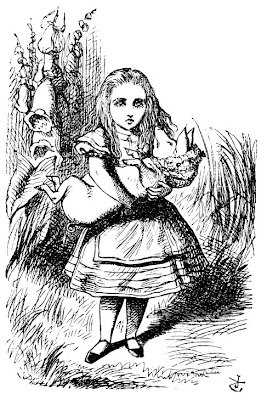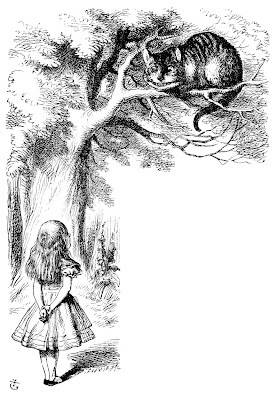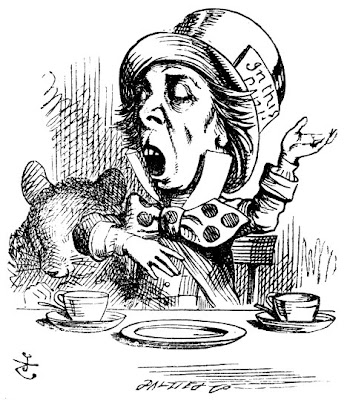And then of course are the Tenniel illustrations:
 |
| 1:11, The Fish footman delivers a Large Invitation to the Frog footman. |
 |
| 3:58, Too much pepper, and too much baby. |
Tenniel apparently based his duchess here upon a 1513 painting by Quentin Matsys called The Ugly Duchess. She says that that cat grins because he is a Cheshire Cat, making reference to an English phrase of the time "to grin like a Cheshire cat." No one is quite sure what in the world that means.
The song that the Duchess sings -- "Speak Roughly to Your Little Boy" -- is, like Carroll's other poems so far, a parody of a justly forgotten poem of the time, this one called "Speak Gently," by David Bates.
 |
| 9:26, Mr. Carroll did not have a High Opinion of Little Boys. |
 |
| 10:01, Truly, the Cat is the only one who Makes Sense. |
 |
| 13:20, A Grin without a Cat. |
 |
| 14:49, Alice is not overly enjoying this Tea Party. |
Carroll says he never originally intended "Why is a raven like a writing desk?" to have an answer, but of course people attempted to supply them anyway. Some of my favorite answer are "Because Poe wrote on both" and "Because the notes for which they are noted are not noted for being musical notes." Apparently, Carroll eventually tired of people asking him what the answer was, so in the preface to the 1896 edition he provided one, which came down to us as "Because it can produce a few notes, tho they are very flat; and it is never put with the wrong end in front!" Which, sort of makes sense. It turns out, though, that this answer was the victim of an overzealous copy-editor in later editions, and what Carroll originally wrote was "...and it is nevar put with the wrong end in front!"
Carroll liked layers of meanings.
 |
| 20:10, The Hatter recites most eloquently. |
Unlike the other poems thus far, everyone nowadays still recognizes the source material that "Twinkle Twinkle Little Bat" is parodying. What's funny is that "Twinkle Twinkle Little Star" actually has FOUR stanzas beyond the only one anyone really knows (and the one the Hatter is referencing.) Also, I was WELL into my 20s before I realized that this, "Baa Baa Black Sheep," and the alphabet song all used the same melody, and it BLEW MY MIND.
 |
| 25:57, The Dormouse receives a Tea Swirlie. |
All illustrations are courtesy of Lenny's Alice in Wonderland Site.
If you would like to read along, the text can be found at Project Gutenberg. No reading ahead, though!

No comments:
Post a Comment